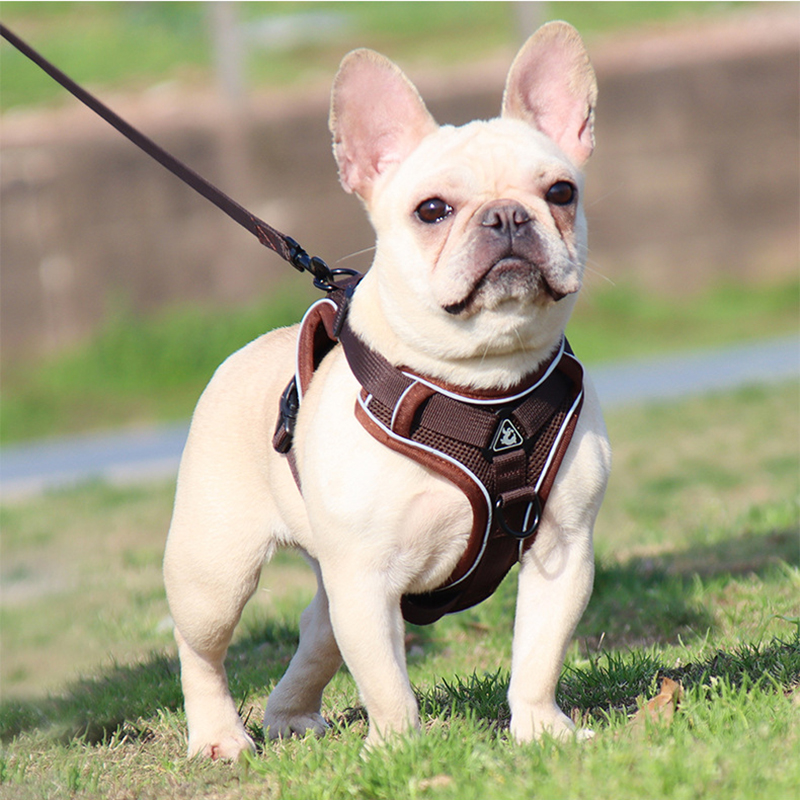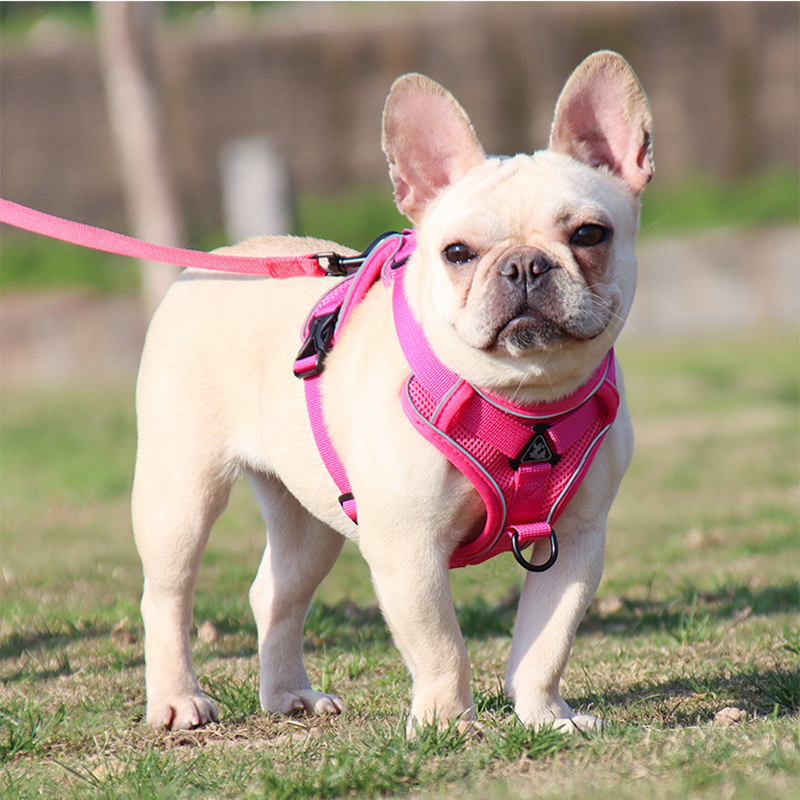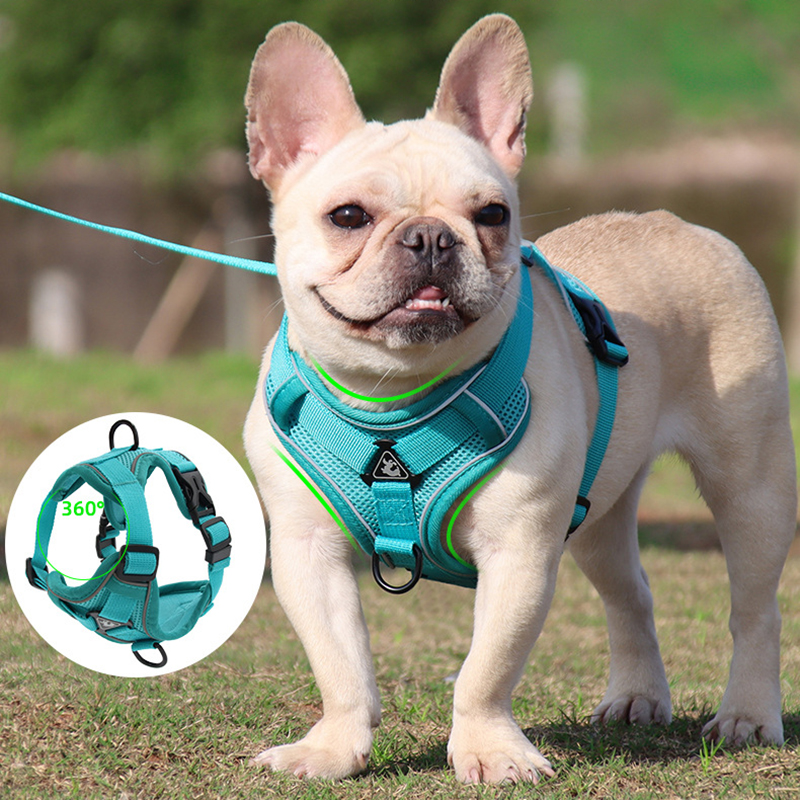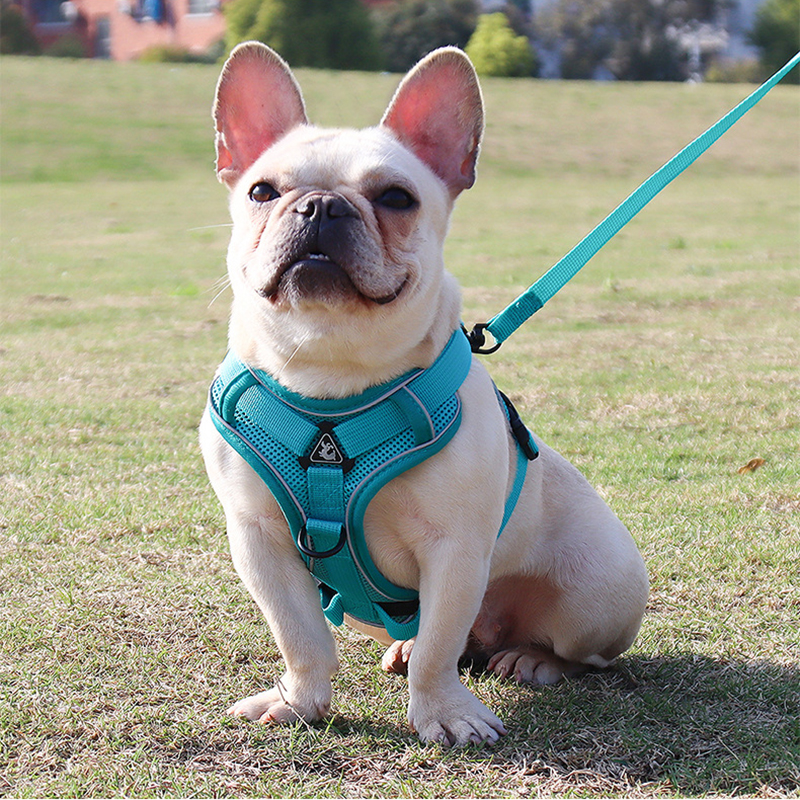The Importance of Proper Harness Fit
Choosing the right harness for your dog is crucial. A good fit promotes safety and comfort. A harness that is too tight can cause chafing and restrict breathing. One that’s too loose may let your dog slip out and run into danger. Proper harness fit supports better control during walks and reduces the risk of neck strain from pulling. Moreover, an ill-fitting harness could hamper your dog’s natural movements, possibly leading to muscle strain or injury. Measuring your dog for a harness is not just about comfort, it ensures their well-being during daily activities and exercise.

Different Types of Dog Harnesses
When you’re looking at how to measure a dog for a harness, it’s important to know the different types available. Harnesses come in various shapes and styles to suit different needs. Let’s explore the main types you might consider:
Standard Harnesses
Standard harnesses often have a basic design. They usually feature straps that go around the dog’s chest and neck. They’re good for smaller dogs or those that don’t pull much.
No-Pull Harnesses
No-pull harnesses are great for dogs that tend to tug on the leash. They typically have a front attachment point. When the dog pulls, it’s gently steered to the side, discouraging pulling behavior.
Step-In Harnesses
Step-in harnesses are perfect for dogs that dislike having harnesses pulled over their heads. The dog steps into the loops and you fasten the harness on the back.
Vest Harnesses
Vest harnesses are more padded and offer more coverage. They’re especially useful for dogs in colder climates or those with sensitive skin.
Tactical Harnesses
For working dogs or those that go on adventures, tactical harnesses are sturdy. They often have handles and attachment points for gear.
Remember, the right type of harness will depend on your dog’s size, breed, behavior, and activity level. Selecting the right type will ensure comfort and safety for your dog.
Essential Measurements for a Harness
When selecting a harness, three key measurements are vital: the neck, the chest, and the dog’s weight. These measurements ensure the harness fits well and provides comfort and safety.
Neck Measurement
To measure the neck, find the widest part around your dog’s neck where the collar would sit. Place a flexible tape measure around this part. Ensure it’s snug but not too tight. Leave enough space to fit two fingers between the tape and your dog’s neck. This allows for breathing room and ensures the harness won’t choke your dog.
Chest Measurement
The chest is the most important area for harness fit. Measure the widest part of your dog’s chest, usually just behind the front legs. Bring the tape measure around the chest and back to the starting point. Again, the fit should be snug but with enough room to fit two fingers beneath the measuring tape. This prevents the harness from being too tight, allowing free movement.
Weight Consideration
While not a direct measurement, knowing your dog’s weight is crucial. Weight can influence the harness size and strength needed to ensure it holds up during use. Heavier dogs may require a sturdier harness. Be sure to check the harness’s weight limit before purchasing.
Step-by-Step Guide to Measuring Your Dog
Follow these steps to ensure you get accurate measurements for your dog’s harness:
Prepare Your Measuring Tools
First, get a flexible tape measure. A cloth one works best for the contours of your dog’s body. Have treats ready to keep your dog still.
Position Your Dog Correctly
Have your dog stand up. Make sure they’re on a level surface. They should be calm and relaxed.

Measure The Neck
Locate the widest part of your dog’s neck where a collar would sit. Wrap the tape measure around this area. It should be snug, with enough room for two fingers to fit between the tape and their neck.
Measure The Chest
Find the broadest part of the chest, right behind the front legs. Circle the tape measure around the chest and note the size. Remember the two-finger rule under the tape for comfort and mobility.
Note Down The Weight
Check your dog’s weight using a pet scale or vet visit. Use this to confirm the harness can support your dog’s size.
Remember to use the keywords ‘how to measure a dog for a harness’ throughout. Aim for concise sentences, simplicity in wording, and to ensure the text is clear and easy to follow. Keep the steps straightforward and avoid any complicating language or jargon.
Tips for Choosing the Right Harness Material
Choosing the right harness material is vital for your dog’s comfort and safety. Here are some tips to keep in mind:
Consider Durability
Opt for materials that can withstand wear and tear. Nylon and leather are popular for their strength.
Look for Comfort
The harness should not irritate your dog’s skin. Padded materials like fleece can provide extra comfort.
Check for Washability
A harness will get dirty. Look for materials that are easy to clean and quick to dry.
Think about Weather
If you’re in a hot climate, breathable materials are a must. For cold weather, choose insulated fabrics to keep your dog warm.
Reflective Features
For safety during night walks, materials with reflective properties are a smart choice.
Hypoallergenic Options
If your dog has allergies, hypoallergenic materials can prevent discomfort and reactions.
When learning how to measure a dog for a harness, remember that the right material is as crucial as the correct fit. It contributes to the overall comfort and functionality of the harness during everyday use. Always touch and feel the material, if possible, to ensure it meets your dog’s needs and your personal preferences.
Adjusting the Harness for a Secure Fit
Once you have the right harness and measurements, ensuring a secure fit is the next step. Here’s how to do it:
Check the Initial Fit
Put the harness on your dog following the product’s instructions. The harness should not be too tight or too loose. You should be able to place two fingers under any strap. If you can’t, it’s too tight. If the harness slides freely, it’s too loose.
Adjust the Straps
Most harnesses have adjustable straps. If the harness has buckles, open them and gently pull the straps to tighten or loosen. If it has Velcro, peel it back and reposition. Always adjust slowly and check the fit as you go. This ensures you don’t make it too tight.
Test the Harness Movement
Once adjusted, observe your dog moving in the harness. They should move freely and comfortably. Watch for any signs of discomfort or restricted movement. If they seem uneasy or struggle to walk, you may need to adjust the fit further.
Secure the Fastenings
After the final fit check, secure all fastenings. These might be buckles, clasps, or Velcro. Make sure they’re fastened properly and won’t come undone easily.
Final Fit Check
For the last step, take your dog for a short walk. Pay attention to how the harness sits. If the harness stays in place and your dog walks without issues, you have achieved a secure fit. If the harness shifts or your dog seems bothered, it may need further adjustment.
Remember, the keywords ‘how to measure a dog for a harness’ are part of this process. A proper fit starts with accurate measurement, followed by careful adjustment. This ensures your dog’s comfort and safety on every walk.
Troubleshooting Common Fit Issues
When learning how to measure a dog for a harness, it’s common to encounter fit problems. Here are ways to troubleshoot them:

Harness Is Too Tight
If the harness is too tight, your dog may show discomfort. It may also leave marks on the skin. Loosen the adjustable straps a bit at a time. Check the fit again after each adjustment.
Harness Is Too Loose
A loose harness can slip off. It’s a safety risk. Tighten the straps gradually. Watch that it doesn’t become too snug. Ensure the two-finger space remains under the straps.
Strap Chafing
Chafing suggests the material or fit isn’t right. Consider a harness with softer material. Adjust the harness so that it doesn’t rub against the same spot.
Dog Hesitant to Walk
If your dog resists while walking, the harness may be uncomfortable. Check for any points where the harness may be applying too much pressure. Adjust those areas carefully.
Harness Twists During Walks
A twisting harness can be due to uneven strap lengths. Make sure all straps on both sides are adjusted to the same length for balance.
Dog Escaping the Harness
If your dog escapes, it’s a sign that the fit is incorrect. Ensure that the chest and neck measurements are accurate. Re-adjust the harness for a better fit.
By troubleshooting these issues, you can ensure a comfortable, secure fit for your dog.
Recommended Harnesses for Different Dog Breeds
Choosing the right harness can vary based on your dog’s breed. Small breeds often have delicate bodies. For them, a soft, lightweight harness is best. It prevents pressure on their small frames. Medium breeds are versatile. They can use most harness styles, from standard to no-pull. It depends on their pulling habits. Large breeds need strong, durable harnesses. Go for ones that can handle their strength and size. Custom-adjustable harnesses work well for these dogs. Active breeds benefit from tactical or sports harnesses. They are tough and come with added features for outdoor activities.
When you think about how to measure a dog for a harness, consider breed-specific needs. Some breeds have unique body shapes. Dachshunds have long bodies. They need harnesses that distribute pressure evenly. Bulldogs have broad chests. Choose a harness that fits well around their girth without restricting breathing. Greyhounds have slim necks and may require a harness that doesn’t slip easily. Research your dog’s breed to find the best option for their build. Always double-check measurements to ensure the perfect fit.
Aligning with the blog’s goal, keep sentences short and straightforward. Don’t forget to use the keywords ‘how to measure a dog for a harness.’ Try to keep the content clear and precise, as previously explained in the blog sections above.
